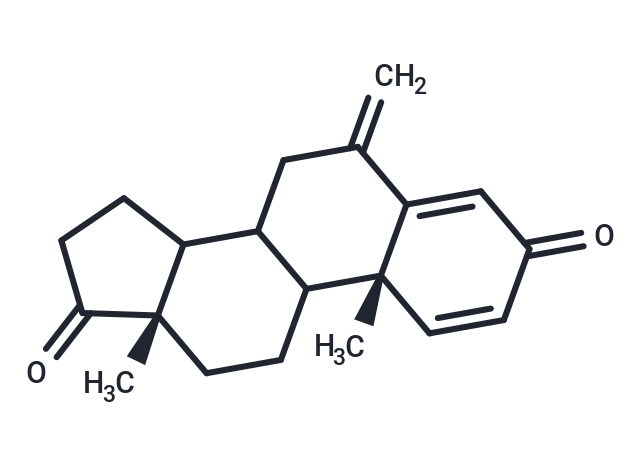Shopping Cart
- Remove All

Your shopping cart is currently empty



| Description | Exemestane (EXE) is an Aromatase Inhibitor. The mechanism of action of exemestane is as an Aromatase Inhibitor. |
| Targets&IC50 | Aromatase (rat):40 nM, Aromatase (human):30 nM |
| Kinase Assay | Assays with human placental aromatase: Microsomes are prepared from human placenta and stored at -80℃. The rate of aromatization is determined by measuring the tritiated water released from [1β-3H]A. The assay is carried out in a final volume of 1 mL, in 10 mM phosphate buffer, pH 7.5, containing 100 mM KCl, 1 mM EDTA, 1 mM dithiothreitol, 100 μM NADPH, the enzyme preparation and the appropriate concentrations of Exemestane (in duplicate) and the substrate. After a 10 min incubation at 37 ℃, the assay is terminated by the addition of 4 mL cold chloroform. The acqueous phase is treated with a charcoal suspension, the supernatant is removed and counted for radioactivity by liquid scintillation in Rialuma. For the determination of the IC50 values, various concentrations of Exemestane are incubated with 20 μg of microsomal protein, in the presence of a fixed amount (50 nM) of [3H]A. |
| Cell Research | hFOB is treated with steroids and Exemestane for 24 hours, when specimens are harvested and evaluated for cell proliferation using the WST-8 method. Optical densities (OD, 450 nm) are evaluated using a SpectraMax 190 microplate reader and Softmax Pro 4.3 microplate analysis software. The status of proliferation (%) is calculated according to the following equation: (cell OD value after test materials treated /vehicle control cell OD value)× 10(Only for Reference) |
| Alias | EXE, FCE 24304, PNU155971 |
| Molecular Weight | 296.4 |
| Formula | C20H24O2 |
| Cas No. | 107868-30-4 |
| Storage | ||||||||||||||||||||||||||||||||||||
| Solubility Information | DMSO: 2.96 mg/mL (10 mM), Sonication is recommended. Ethanol: 22.2 mg/mL (75 mM) | |||||||||||||||||||||||||||||||||||
Solution Preparation Table | ||||||||||||||||||||||||||||||||||||
DMSO/Ethanol
Ethanol
| ||||||||||||||||||||||||||||||||||||

Copyright © 2015-2024 TargetMol Chemicals Inc. All Rights Reserved.